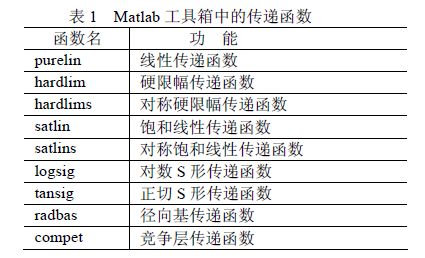MATLAB BP神经网络用法的总结(试用于初学者)
BP(back propagation,反向传播)神经网络功能及其MATLAB实现。
反向传播指误差函数会由输出端向前反向传播,隐含层借此调整权值来缩小误差。
结构图:
W为权值,b为阈值。
1. 数据输入:数据输入时需先使用传递函数进行变化,变换方法包括阈值(阶跃)函数、分段线性变换、归一化函数(mapminmax)、对数S形变换(logsig)、正切S形变换(tansig)。
2. 神经网络创建:
创建函数newcf,该函数创建级联前向BP神经网络。
Description
newcf(P,T,[S1 S2...S(N-1)],{TF1 TF2...TFN},BTF,BLF,PF,IPF,OPF,DDF)takes,
P - RxQ1 matrix of Q1representative R-element input vectors.
T - SNxQ2 matrix of Q2representative SN-element target vectors.
Si - Sizes of N-1 hidden layers,S1 to S(N-1), default = [].
(Output layer size SN is determined from T.)
TFi - Transfer function of ith layer. Default is 'tansig' for
hidden layers, and 'purelin' for output layer.
BTF - Backprop network training function, default = 'trainlm'.
BLF - Backprop weight/bias learning function, default = 'learngdm'.
PF - Performance function,default = 'mse'.
IPF - Row cell array of input processing functions.
Default is {'fixunknowns','remconstantrows','mapminmax'}.
OPF - Row cell array of output processing functions.
Default is {'remconstantrows','mapminmax'}.
DDF - Data division function, default = 'dividerand';
and returns an N layer cascade-forward backprop network.
net = newcf(P,T,[S1 S2...S(N-1)],{TF1TF2...TFN},BTF,BLF,PF,IPF,OPF,DDF)
PR:每组输入(共有R组输入)元素的最大值和最小值组成的R*2维矩阵;
Si:第i层的长度,共计N层;
TFi:第i层的传递函数,默认隐含层为tansig,输出层为purelin,输入为两个字符串构成的矩阵,取值范围:
BTF:BP网络的训练函数,默认为trainlm,即Lecenberg-Marquardt函数,可设置为traingd,梯度下降BP算法训练函数,traindm,动量反传的梯度下降BP算法训练函数,trainda,动态自适应学习速率的梯度下降BP算法训练函数,traindx,动量反传和动态自适应学习速率的梯度下降BP算法训练函数。
BLF:权值和阈值的BP学习算法,默认为learngdm,带动量项,可设置为learngd,不带动量项。
PF:网络的性能函数,即训练误差的计算方法,默认为mse,即均方差,可设置为mae,均值绝对误差。
IPF:输入处理函数。
OPF:输出处理函数。
DDF:验证数据划分函数。
后面三个参数一般不设置,取系统默认即可。
创建函数newff,该函数创建前向神经网络。
Description
newff(P,T,S) takes,
P - RxQ1 matrix of Q1representative R-element input vectors.
T - SNxQ2 matrix of Q2representative SN-element target vectors.
Si - Sizes of N-1 hidden layers,S1 to S(N-1), default = [].
(Output layer size SN is determined from T.)
and returns an N layer feed-forward backprop network.
newff(P,T,S,TF,BTF,BLF,PF,IPF,OPF,DDF) takes optional inputs,
TFi - Transfer function of ith layer. Default is 'tansig' for
hidden layers, and 'purelin' for output layer.
BTF - Backprop network training function, default = 'trainlm'.
BLF - Backprop weight/bias learning function, default = 'learngdm'.
PF - Performance function,default = 'mse'.
IPF - Row cell array of input processing functions.
Default is {'fixunknowns','remconstantrows','mapminmax'}.
OPF - Row cell array of output processing functions.
Default is {'remconstantrows','mapminmax'}.
DDF - Data division function, default = 'dividerand';
and returns an N layer feed-forward backprop network.
P:输入数据矩阵;
T:目标数据矩阵;
S:隐含层节点数;
其他参数同newcf。
传递函数
Logsig
Tansig
学习函数
Learngd函数
[dW,LS] =learngd(W,P,Z,N,A,T,E,gW,gA,D,LP,LS)
W:权值矩阵;
P:层输入向量;
Z:层输入经过加权函数变换后的加权输入矢量;
N:加权输入经过输入函数计算后得到的神经元传递函数的输入矢量;
A:该层神经元输出矢量;
T:目标矢量;
E:误差矢量;
gW:网络性能对于权值的梯度矢量;
gA:网络性能对于该层输出梯度矢量;
D:神经元的距离矩阵;
LP:学习参数,learngd函数的学习参数是由学习速率LP.lr构成的,默认值为0.01;
LS:学习状态,初始值为[],函数返回阈值调整量dW和当前学习状态LS。
Learndm函数
参数同上。
训练函数
Trainbfg准牛顿BP算法函数
[net,TR =trainbfg(Net,Tr,trainV,valV,testV)
Net:待训练的神经网咯;
Tr:有延迟的输入网络;
trainV:训练向量;
valV:验证向量;
testV测试向量;
net:训练后的神经网络;
TR:每步训练的有关信息,包括:
TR.epoch:时刻点;
TR.perf:训练性能;
TR.vperf:确认性能;
TR.tperf:检验性能。
info=trainfg(‘info‘);返回函数的有用信息。
常规参数:
net.trainParam.epochs:训练次数,默认值为100.
net.trainParam.goal:网络性能目标,默认值为0。
net.trainParam.max_fail:最大验证失败次数,默认值为5.
net.trainParam.min_grad:性能函数的最小梯度,默认值为1e-6.
net.trainParam.show:两次显示之间的训练次数,默认值为25。
net.trainParam.time:最大训练时间(秒),默认值为INF。

